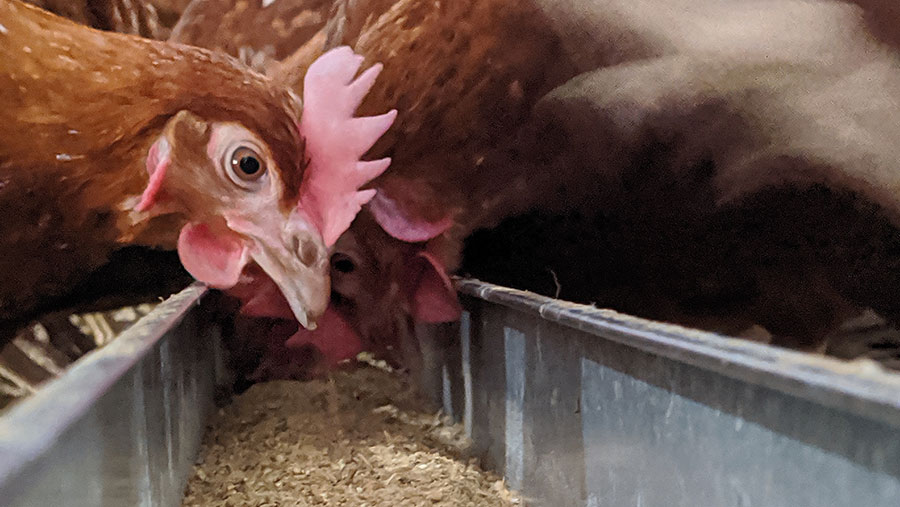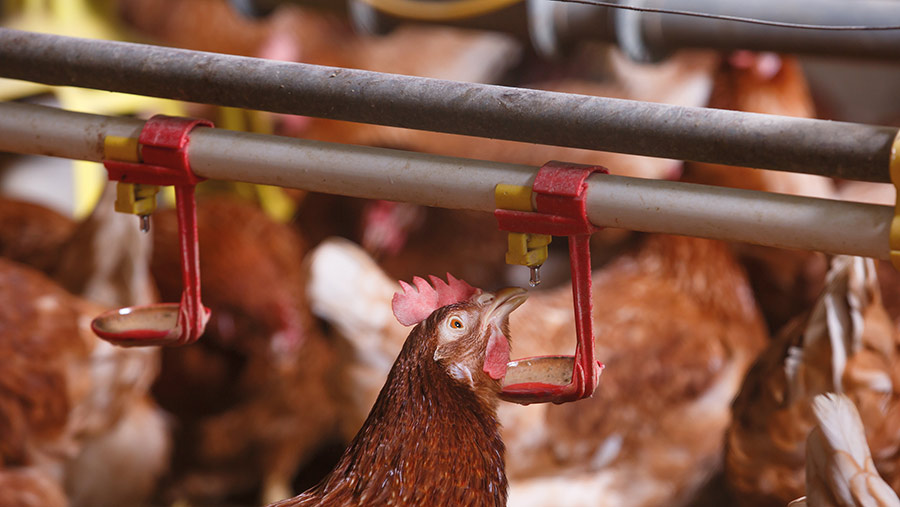6 key ways poultry farmers can control feed costs
 © Valdisskudre/Adobe Stock
© Valdisskudre/Adobe Stock Feed prices soared to almost 20% above the five-year average during 2021, driving up poultry farm costs and cutting margins.
This has put feed management firmly under the spotlight for poultry producers.
We asked Jim Turner, head of poultry at agricultural supply company Wynnstay, for tips on how to keep costs in check without affecting quality.
See also: How poultry farm is saving 10% on feed costs with home mill
1. Watch the market
Too often poultrykeepers have a routine approach to buying feed and this exposes their business to volatile spot prices.
Ordering feed in this way can be costly. Managers should understand that raw materials are traded globally on commodity markets.
The price is no longer a case of what happens between two or three different suppliers down the road, but rather what is happening to supply in places such as North and South America.
Prices are further affected by market insights into demand levels, particularly in China.
Fund managers study the insights along with weather and crop forecasts and then react by buying or offloading shares in valuable arable commodities, specifically soya.
It is here where the prices for raw materials can be influenced.
Flock managers should, therefore, immerse themselves in the workings and fluctuations of the market to spot early indicators of price changes.
It is relatively easy through data posted online from the US Department of Agriculture, the AHDB, stock-trading companies and farming publications such as Farmers Weekly.
Advisers, consultants and feed manufacturers will also provide support in tying down deals as they, too, will be looking to secure forward raw material.
Farmers who have done this have been able to lock in to markets at lower prices and have bought ahead.
With this approach, farms have saved £40-£45/t over units that have taken whatever price was available.
As well as the potential to make these savings, buying further ahead allows producers to calculate margins above the egg price. This can then help manage costs and schedule investments.
2. Take care with ingredients
Soya is the main source of protein used due to its nutritional properties. But at times of extremely high prices, merchants and home-millers and mixers will look to mitigate costs with alternatives such as field beans and sunflowers to stay competitive.
However, if the flock is laying really well and there is a solid margin over the egg price, it may be a false economy to tinker with the ration. Ingredient changes need to be carried out with support and careful monitoring.
Managing costs is one thing, but cutting corners is another, and not advisable.

© Wynnstay
3. Cut waste in storage
Positioning of silos is extremely important to cut wastage.
The feed is only shielded from the weather by the silo’s relatively thin metal skin, which is a poor insulator and offers little protection against temperature changes.
Intense sunlight or freezing temperatures can have a detrimental effect on the feed.
Vital components such as yolk pigments, vitamins and minerals can begin to degrade if the sun hits the silo on days when outside temperatures exceed 25C, potentially heating up the feed.
For new sheds, positioning silos in areas that are less exposed to the cold or direct sunlight will help preserve the ration.
Existing sites face a bigger challenge if there is no cover, but erecting shades and planting trees would be worthwhile to stop the spoilage.
Apart from temperatures, worn or dirty storage equipment can result in losses.
Augers, cyclones and dust traps need regular cleaning, otherwise blockages can occur. This can cause feed to separate into large and fine particles when it is blown into the bin on delivery.
Breakages and holes must also be addressed. An auger pipe that leaks feed can cause expensive, cumulative losses and attract pests and vermin. Rats and squirrels can cause further damage, potential contamination and feed losses.
Holes also allow moisture into the bin, causing feed to degrade and cake onto surfaces and seams.
To avoid this, the bin should be opened up and given a really good clean regularly.
4. Tailor feed to the flock
Every flock cycle is different. The season, weather, inside environment, breed and health profile may alter the birds’ nutritional requirements compared with the previous flock’s.
It is common to see the same feed regime flock after flock, plugged into the computer six feeds a day because that is the routine.
But this can lead to selective feeding, lower feed intake, undersized eggs, digestive problems and wasted feed in the tracks and hoppers.
To avoid these costly issues the feed regime requires active management.
Poultrykeepers should take time to go in and watch how fast each flock goes through the feed.
This is important, not just because of the obvious waste, but because the birds need to consume the whole diet.
The medium and coarse grains will be picked out readily, but the small particles, known as fines, contain the amino acids, enzymes and minerals which are critical nutritional components that promote bird health, growth and egg production.
These won’t be eaten if the regime allows feed after feed to build up.
It is advisable to implement a rigorous “eat-out” period in the mornings.
The flock wakes up, the lights come on and the birds feed before heading to the nest boxes and going through the laying cycle.
This feed period should allow the birds to finish up every last bit on the track.
This will ensure they have all of the essential parts of the diet, but also means they will adopt a useful routine and won’t pop back to feed when they should be in the nest boxes.
This will reduce the number of costly floor eggs and helps birds settle.
Subsequent feeds should be monitored with levels right down to the bottom of the track, and birds can be observed eating the fines before the next feed run begins.
This will need daily monitoring to establish the pattern and adapting the run to ensure birds eat down while avoiding them going hungry. A little-and-often approach will help drive appetite while keeping hens satisfied and content.
This should be monitored and adjusted as the seasons change and birds mature.
Finally, all hoppers and tracks should be thoroughly cleaned at turnaround. This is essential to allow accurate feeding and avoid costly equipment breakdowns and health issues in the incoming flock.
5. Manage the environment
Feed intake and conversion can be linked to the conditions inside the house, with temperature management key to controlling feed costs.
When the temperature drops hens use energy to generate heat instead of maintaining egg production and body condition.
The knock-on effect from high feed intake is a loss of control over egg size and poor gut health.
Similarly, if temperatures are too high, feed consumption falls below the hens’ nutritional requirements and egg size can then decrease.

© Wynnstay
Humidity, drafts and other air quality issues will also have an influence. It is, therefore, worth monitoring and fine-tuning the environmental factors until feed conversion and feed intake are optimised.
To work out the feed conversion ratio (FCR) calculate how much birds have consumed to produce a tonne of eggs.
To gauge whether the farm is achieving a good FCR, look at the breed targets in the breeder’s manual.
Alternatively, using an online, cloud-based benchmarking tool can help. Contributors submit their own farm data and can see how they stack up against other farms.
Any shortfall from the average can then be tackled by tweaking environmental factors or the ration.
6. Focus on rations
Most commercial layers have a range of rations – for example, starter, early-, mid- and end-of-lay.
These are tailored to the birds’ nutritional requirements as they grow and mature throughout the laying period. The rations contain varying combinations of amino acids, calcium and protein.
Early rations are formulated to provide the growing bird with the nutrients it needs for muscular and skeletal development, as well as egg production.
As it matures, the need to fuel that growth diminishes.
However, a common fault in feed management is a failure to introduce the next ration at the appropriate point in the maturing flock.
Providing the early ration beyond the time it is needed is a waste of money, and the additional nutrients can ultimately be detrimental to flock health and push up or depress feed consumption and egg size.
To get the optimum economical and physical performance, it is important to focus on the flock rather than a date in the calendar.
Data from the flock – such as feed intake, bodyweight, egg mass and FCR – is key to knowing when to switch.
It is important to understand the specific breed requirements and the limitations of the specific diet.
Feed diets and ration ranges will differ between feed manufacturers, so adhering to specialist advice and cross-referencing feed and breed guides and targets will avoid feeding diets not matched to the stage and age of the flock.
This will supply the hens with optimum levels of vitamins, minerals, protein, energy and fibre. Combining this allows the feed to help the flock achieve its full genetic potential.
